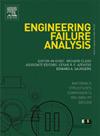Stress-medium synergistic hot corrosion failure mechanism and kinetics model of a Ni-based superalloy
IF 5.7
2区 工程技术
Q1 ENGINEERING, MECHANICAL
引用次数: 0
Abstract
The hot corrosion behavior of a Ni-based superalloy was investigated under tensile stresses of 0, 60, and 120 MPa at 750 °C using XRD, OM, SEM, and EDS. The corrosion medium consisted of a 75 % Na2SO4–25 % NaCl salt mixture. The influence of tensile stress on oxide film microstructure, elemental diffusion, and corrosion kinetics was systematically analyzed. Results revealed that tensile stress accelerated hot corrosion via two key mechanisms: (1) enhancing the bidirectional diffusion of Cr and S, and (2) degrading the oxide film’s integrity. The thickness of Cr-depleted layers, which varied with applied stress, served as a quantitative indicator of corrosion kinetics. The corrosion process progressed through three distinct stages, corresponding to oxide film growth, cracking/spalling, and reformation. A synergistic degradation mechanism was proposed, combining stress and hot corrosion effects. Outward Cr diffusion initially formed a protective Cr2O3-rich layer, but tensile stress and corrosive salts jointly shortened its protective lifespan. Subsequent Cr2O3 spalling enabled deeper salt penetration, inducing grain boundary embrittlement and accelerated substrate degradation.
ni基高温合金应力-介质协同热腐蚀失效机理及动力学模型
采用XRD、OM、SEM和EDS等方法研究了一种镍基高温合金在750℃、0、60和120 MPa拉伸应力下的热腐蚀行为。腐蚀介质为75% na2so4 - 25% NaCl盐混合物。系统分析了拉伸应力对氧化膜微观结构、元素扩散和腐蚀动力学的影响。结果表明,拉伸应力通过两个关键机制加速热腐蚀:(1)增强Cr和S的双向扩散;(2)降低氧化膜的完整性。贫铬层的厚度随外加应力的变化而变化,是腐蚀动力学的定量指标。腐蚀过程经历了三个不同的阶段,分别是氧化膜生长、开裂/剥落和重组。提出了应力效应和热腐蚀效应相结合的协同降解机理。Cr向外扩散初期形成了一层富含cr2o3的保护层,但拉伸应力和腐蚀盐共同缩短了保护层的寿命。随后的Cr2O3剥落使盐渗透更深,导致晶界脆化,加速基体降解。
本文章由计算机程序翻译,如有差异,请以英文原文为准。
求助全文
约1分钟内获得全文
求助全文
来源期刊

Engineering Failure Analysis
工程技术-材料科学:表征与测试
CiteScore
7.70
自引率
20.00%
发文量
956
审稿时长
47 days
期刊介绍:
Engineering Failure Analysis publishes research papers describing the analysis of engineering failures and related studies.
Papers relating to the structure, properties and behaviour of engineering materials are encouraged, particularly those which also involve the detailed application of materials parameters to problems in engineering structures, components and design. In addition to the area of materials engineering, the interacting fields of mechanical, manufacturing, aeronautical, civil, chemical, corrosion and design engineering are considered relevant. Activity should be directed at analysing engineering failures and carrying out research to help reduce the incidences of failures and to extend the operating horizons of engineering materials.
Emphasis is placed on the mechanical properties of materials and their behaviour when influenced by structure, process and environment. Metallic, polymeric, ceramic and natural materials are all included and the application of these materials to real engineering situations should be emphasised. The use of a case-study based approach is also encouraged.
Engineering Failure Analysis provides essential reference material and critical feedback into the design process thereby contributing to the prevention of engineering failures in the future. All submissions will be subject to peer review from leading experts in the field.
 求助内容:
求助内容: 应助结果提醒方式:
应助结果提醒方式:


